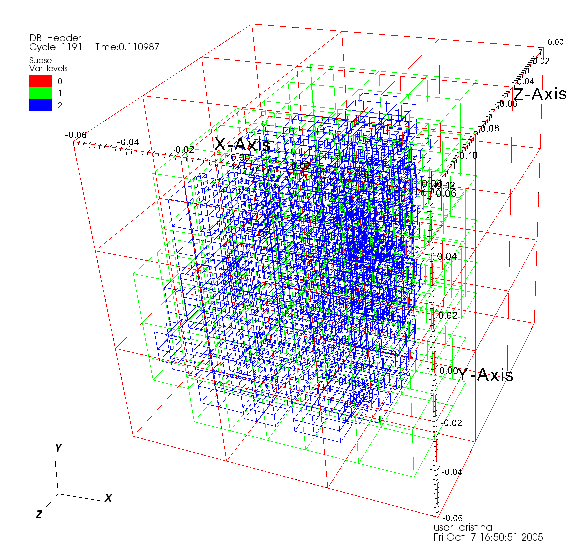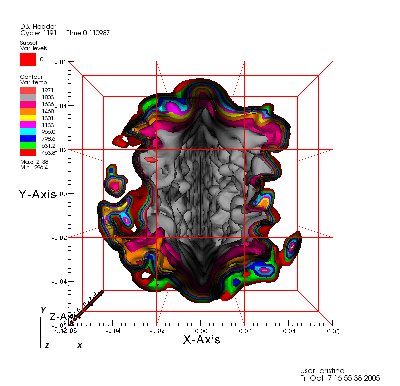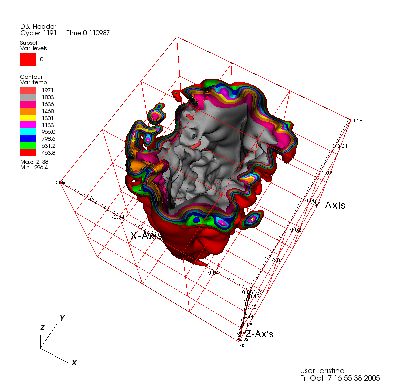This is an archival copy of the Visualization Group's web page 1998 to 2017. For current information, please vist our group's new web page.
DaVinci.nersc.gov: Parallel Remote Visualization of AMR Combustion data using VisIt
Table of Contents
Introduction
DaVinci is an SGI Altix 350 server running the SGI ProPack 4 64-bit Linux operating system, based on SUSE Linux Enterprise Server 9 (SLES9). Its main purpose is to provide visualization and data analysis capabilities to the NERSC user community. It is named after the famous Italian artist and scientist Leonardo da Vinci, due to its intended combination of visual imagery of technical information. DaVinci is a unique resource among NERSC's collection of compute platforms. It consists of 32 Intel Itanium-2 processors with 192 GB of shared memory. While DaVinci is primarily intended to support NERSC's analytics program, its architecture is well-suited for OpenMP and threaded applications. Intel compilers provide high levels of optimization. Another unique characteristic of DaVinci is its support of long-running interactive jobs. Other NERSC platforms provide interactive resources for the purpose of code development and debugging; DaVinci provides generous interactive access to assist researchers in analyzing their results from production runs on Seaborg and Jacquard.
DaVinci consists of 32 CPUs with 192 GBytes of shared memory. Each CPU is a 64-bit Intel Itanium-2 processor, running at 1.4 GHz, with a theoretical top speed of 5.6 GFlops/sec. See the NERSC web pages for more information on this resource.
Visualization using VisIt
Among the visualization sofware packages available in DaVinci there are three that offer a client-parallel backend architecture (CEI Ensight, Paraview and VisIt). Among them VisIt provides support for reading AMR data files.
VisIt employs a distributed and parallel architecture in order to handle extremely large data sets interactively. VisIt's rendering and data processing capabilities are split into viewer and engine components that may be distributed across multiple machines:
- Viewer: Responsible for rendering and is typically run on a local desktop or visualization server so that it can leverage the extremely powerful graphics cards that have been developed in the last few years.
- Engine: Responsible for the bulk of the data processing and input/output (I/O) and is typically run on a remote machine where the data is located. This eliminates the need move the data and makes high-end compute and I/O resources available to it. The engine can be run serially on a single processor or in parallel on thousands of processors.
For this demo we choose an AMR data of a three-dimensional, time-dependent simulation of a laboratory-scale rod-stabilized premixed turbulent V-flame run in NERSC computers [1]. The 17G data set consists of a four level mesh writen using the BoxLib format. VisIt allows to subset the dataset using the different AMR levels. Figure 1 shows the AMR grids extracted with the subset operator. Figure2 shows isosurfaces of temperature using the contour utility.

|

|
| Level 0 | Level 0-1 |

|

|
| Level 0-2 | Level 0-3 |

|
References
[1] J. B. Bell, M. S. Day, I. G. Shepherd, M. Johnson, R. K. Cheng, J. F. Grcar, V. E. Beckner, M. J. Lijewski, "Numerical Simulation of a Laboratory-Scale Turbulent V-flame", LBNL Report LBNL-54198-Journal, Proc. Natl. Acad. Sci. USA, 102(29), 10006-10011, 2005.
